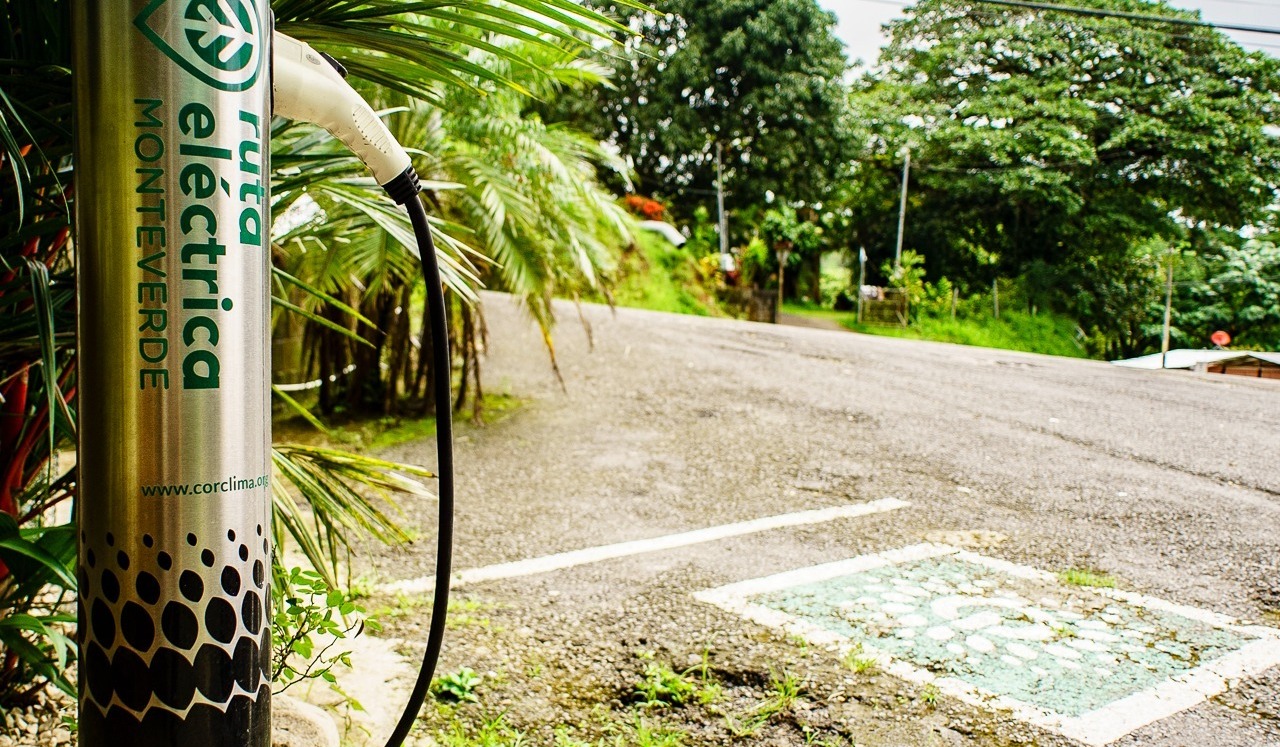A History of Monteverde, Part 2

Conservation, Tourism, and The Future of Monteverde. Last week on our blog A History of Monteverde Part 1 we discussed the founding of Monteverde, drawing from Costa Rica’s incredible natural origins, to the origins of the nation, and finally to the founding of this small settlement grounded in the values of peace, education, and conservation.
Today, we discuss how those values have formed the Monteverde that we know today, and how they have shaped the bright future ahead!
Forest Conservation, Research, and Biodiversity
The early Quakers cleared land, constructed homes, had children, bought and milked cattle, and developed a dairy processing plant. The English-speaking population, pleasant and tranquil Costa Rican lifestyle, and fantastic biodiversity drew biologists to Monteverde in the 1960s. These coming scientists discovered the Golden Toad, Monteverde's most famous amphibian, during this period. At the same time, birders began traveling to Monteverde to pursue the elusive Resplendent Quetzal and the Three Wattled Bellbird.
A Couple of Conservationists Change the Game
Conservation in Monteverde was established in 1970 by George and Harriett Powell, two Californian graduate biology students. They hired a tiny cabin on Wolf and Lucky Guindon's property to focus on George's Ph.D. study. Wolf and Lucky, aged twenty and eighteen, joined the original Quakers in 1951, a month after their marriage in Fairhope. Wolf liked to walk and explore the nearby woods, and was one of the few experienced dairy farmers in the group, importing chain saws to speed up the clearing of trees for new pastures for the burgeoning dairy herds.
But when the Powells discovered how quickly the forest was vanishing and how many species were in danger of extinction, they decided they had to do something to slow down the deforestation. They began raising funds from friends and relatives in the U.S. to acquire the primary forest before the locals cut it down. They recruited Wolf Guindon, who knew the forest and most of the homesteaders distributed among the outlying slopes and valleys, to discover desirable parcels of land.
Monteverde Cloud Forest Reserve Was Born
The Powells agreed that the Tropical Science Center in San Jose would handle the funds and watch after the protected land, forming the Monteverde Cloud Forest Biological Preserve (also known as the Monteverde Reserve) (810 acres) in 1972. After that, the World Wildlife Fund provided funds for administrative and vigilance expenditures, and additional money was gathered, and more properties were bought.
The Quaker group had been caring for its Watershed Property for twenty years until they incorporated the area to the Tropical Science Center as part of the Monteverde Reserve, handing over responsibility for its management and maintenance. This deal protected around 2000 hectares (roughly 4940 acres) of land in the Monteverde area, taking the community of Monteverde one step further in conservation and habitat protection.
Several organizations and people continued finding properties, negotiating sales, protecting plants and animals from poachers, maintaining boundaries and trails, and spreading the conservation message throughout the area.
For example, the Cloud Forest Reserve now includes the Peñas Blancas River valley (Close to the Arenal Volcano and La Fortuna) and Monteverde's upper slopes, protecting about 10,000 hectares (26,000 acres) of virgin forests.
And the results have had long-reaching effects. In the mid-1980s, local landowners and biologists discussed the hillsides being deforested by cutting or burning, and how it harmed soil retention, water quality, and ecosystems. And as a result, concerned citizens created the Monteverde Conservation League in 1985. They launched reforestation and environmental education projects, establishing a tree nursery in Monteverde to help reforest windbreaks and tiny tree lots on the Pacific side.

The Monteverde Wildlife League
But the efforts of conservation in Monteverde were just beginning. On a trip to Sweden in 1987, biologist Sharon Kinsmen offered slide shows to public school children. The Monteverde Conservation League inspired the children to gather funds to help safeguard the remaining wilderness.
Over the next four years, Swedish school children raised close to a million dollars to protect Monteverde's woods. The Swedish government matched this donation, and by the early 1990s, the Conservation League had about two million dollars. Excellent brownie sales results!
Children´s Eternal Rainforest
The Conservation League bought over 20,000 hectares (45,000 acres). It was named the Children's Eternal Rainforest ( also known as BEN – Bosque Eterno de los Niños) in 1988 and remains Central America's largest private reserve (now roughly 22,500 hectares or 54,000 acres).
The League employed forest guards to assist defend this enormous region from hunters, tree cutters, squatters, and palm tree poachers (the heart of palm, or palmito as it is known here, is a traditional Easter food, but in the wild, the whole tree is cut to harvest the heart destroying many trees.)
To this day, those initial decisions to pursue conservation have inspired others and continue to have a powerful effect, not only on the health of the community, but also on the economy of the region!
Monteverde Tourism
Tourism began to boom in Costa Rica in the 1980s, especially around Monteverde. With friendly tico locals and English speaking expats, the unique Quaker community, the relatively accessible cloud forest (up the road), and the abundance and diversity of birds, orchids, trees and insects, and butterflies, there is plenty of natural beauty and interesting people to keep a visitor intrigued.
Over time, the number of high-quality hotels and restaurants increased, and adventure tourism was born in Monteverde in the early 1990s. Today, many firms offer all sorts of thrilling experiences, including rappel, horseback trekking, mountain bike, and some of the best long-distance hiking paths in Central America.

The Road to Monteverde
For many years, when I was a tour guide, and they told me I was going to Monteverde, I sighed. The road was hell! It was dusty in the sunny season, and on the good days full of potholes (they were rifts in the bad days!) In the rainy season, it turned from annoying to scary. Mud was the word, and now and then, you could feel the vehicle sliding closer and closer to the cliffs.
The community of Monteverde spent decades discussing the convenience of paving or not the road that accesses the community to the Panamerican Highway.
Conservationists in Monteverde used to be entirely opposed to this as they rather have the sort of visitor that would remain for a few days rather than big crowds coming for one day and leaving. However, dust started to be a health problem for the areas around the road, as one-day tours kept on coming anyway.
The road was finally paved in 2019, and coming up to Monteverde is much nicer, safer, and comfortable now.
%20(1).jpeg?width=800&name=WhatsApp%20Image%202021-11-17%20at%2010.52.46%20AM%20(18)%20(1).jpeg)
The Monteverde Community Fund
The Monteverde Community Fund was founded in 2010 by Monteverde citizens and the Monteverde Institute under the motto: We do better together.
The community was fast transforming, with 6,000 local people and 200,000 annual visitors drawn by our lush forests, and a group of conscious neighbors of Monteverde wanted to prepare the place and its inhabitants for the challenges and possibilities of change now and in the future.
The Center for Responsible Travel and The Monteverde Institute conducted a conference on travelers' philanthropy in 2011, studying how to acquire resources from the influential tourist sector and channel them somewhat towards community-identified activities. And the Monteverde Community Fund was established in 2012 to put these ideas into effect.
Since its inception, the Fund has supported and educated teams that are working on various initiatives. After all, we’re happy to serve our neighbors and stakeholders in Monteverde, from municipal wastewater treatment to forestry projects to motion and exercise programs.
Thanks to the Monteverde Community Fund, community organizations can focus on their areas of expertise backed by unified financial support. And between groups that focus on climate change, literacy, theatre, arts, entertainment, recycling, and more, I’d say it’s working.
In all, it has become a force that magnifies and enriches the work of Monteverde's active citizens, and that’s a big part of the future of Monteverde.
A Twist in the Tale: Covid-19 Strikes Monteverde
On March 16th, 2020, Costa Rica closed its borders to the world as all countries were doing. The travel industry, as we all know, collapsed. And Monteverde suddenly stopped as well. No microbuses with happy faces, no birdwatchers pointing binoculars up, not even trails to walk on. It was an unfortunate surreal experience to walk through Monteverde in those days.
It was like an abandoned Garden of Eden, empty in all its glory.
Everything had to close. Everybody was unemployed. Some of the grocery and essential services stores remained open, but a considerable percentage of the population had no income at all.
Monteverde stands out because the values of the community are genuine and rooted in all its inhabitants; their fighting spirit, dedication, and organization showed off during the COVID-19 pandemic.
They formed the "Comision de Enlace Monteverde," with representatives of more than 12 public and private institutions, as well as representatives of private companies and volunteers.
Part of the aid was coordinated with the Monteverde Community Fund (MCF), fed by donations from international organizations and people living inside and outside the country. Already in 2017, during Storm Nate, it had helped raise funds for the emergency, and in the face of a second crisis, the community came together again.
Members of the Circular Economy Subcommittee identified and inventoried local food producers (vegetables, basic grains, chicken, eggs, cheese, etc.) and made it possible to connect producers with local consumers, using the community's social networks and chats to enable buying/selling with home delivery.
It was anything but easy, but Monteverde survived.
And, of course, as travelers once again began to return to the country, Monteverde thrived. It was one of the first communities to have the majority of the population vaccinated, and nowadays that visitors are back, Monteverde is getting ready for a fantastic future.
The Future of Monteverde
In this writer’s humble opinion, Monteverde is a model community for what we all want the world to be. You can see it needed to be framed in the peaceful and also progressive state of mind of Costa Rica, but it was a long line of events brought Monteverde to be the remarkable and rather unusual place it is.
But that doesn’t mean the lessons learned here are unique to Monteverde!
Its history of stubborn peacemaking with the environment and in the community has created a difference, and it is that lesson that has been shared, and created a ripple throughout the world.
Getting today was not easy — not for Costa Ricans, or Quakers, or visitors — but without a doubt, we stand in the midst of a satisfying and extraordinary journey that still has a thing or two to teach the world.
As I finish writing from one of the gardens at the Ocotea Boutique Hotel, I encourage you to embrace this place while you’re here. Take time to talk to the locals, look beyond the majestic beauty of the place into the happy eyes of the people, and as you hear the vibrating synchronized sounds of the forest, feel how Monteverde remains as proof that, true to the motto, we do better together.
References:
Travel + Leisure. "The World's Most Pristine Forests." Travel + Leisure. n.d. Web. November 9th, 2021. https://www.travelandleisure.com/trip-ideas/nature-travel/the-worlds-most-pristine-forests
Monteverde Cloud Forest Biological Reserve -. "Monteverde Cloud Forest - Monteverde Cloud Forest Biological Reserve." Monteverde Cloud Forest Biological Reserve -. 13 Jan. 2021. Web. November 9th, 2021. https://cloudforestmonteverde.com/cloud-forest/
(3) Wikipedia Contributors. "William Walker (filibuster)." Wikipedia, the Free Encyclopedia. Wikimedia Foundation, n.d. Web. November 9th, 2021. https://en.wikipedia.org/wiki/William_Walker_(filibuster)
Presidencia de la República de Costa Rica. "Comunidad de Monteverde convierte la amenaza de COVID-19 en oportunidad para fortalecer su organización." Presidencia de la República de Costa Rica. 18 Apr. 2020. Web. 10 Nov. 2021. https://www.presidencia.go.cr/comunicados/2020/04/comunidad-de-monteverde-convierte-la-amenaza-de-covid-19-en-oportunidad-para-fortalecer-su-organizacion/
Monteverde Fund. "Our Story | Monteverde Community Fund." Monteverde Fund. n.d. Web. 10 Nov. 2021. <https://www.monteverdefund.org/our-story>




